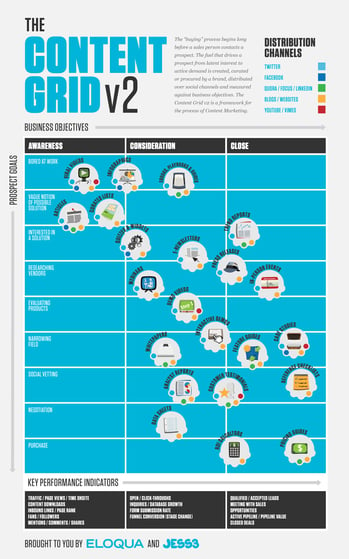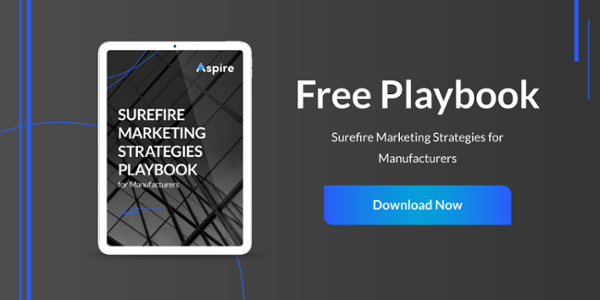- Lead Generation
- Manufacturing
- October 11, 2022
8 Proven Lead Generation Techniques for Manufacturers in 2023

Aaron Marks

It’s 2022, with 2023 right around the corner – marketing has come a long way in today’s era of technology. Marketing automation, artificial intelligence (AI), personalization, account based marketing, and more have totally revolutionized the way marketing is done today.
Why is it, then, that for many manufacturers, their marketing efforts feel like they’re ineffective and are trapped in the past decade?
Marketing tends to be a slower-moving industry than many other B2B disciplines. This has meant that manufacturers can safely remain behind the times – but still continue to grow and meet customer demand.
But over the last few years, demographic changes among the buyers of B2B manufactured products have accelerated. Today, millennials and Gen Z compose more than half of the workforce!
This means that the expectations of your buyers have changed as well. That’s why old-school techniques for generating leads – like cold calling, purchasing email lists, direct mail, tradeshows, and print ads – are no longer delivering the results they did in the past.
This can be perplexing for both marketers and their leadership. When the number and quality of leads start to drop off, leadership will often begin to question their investment into marketing. And when marketers see tactics that they have relied upon for years suddenly fail to deliver, they can feel a bit lost.
Don’t fret too hard. Marketing is still crucial for manufacturers – and it absolutely can deliver consistent, high-quality leads! The key to success is to update your lead generation techniques for the modern buyer. In this article, we’ll explore some proven and tested techniques you can use today to elevate your lead generation efforts.
1. Create Content for Every Stage of the Funnel
I’ve worked with a lot of manufacturers, and when I ask, “Do you have content for your buyers?” the answer I always get is “Yes!”. But then I ask what types of content are available, and it’s almost always the same answer: some combination of spec sheets, data sheets, brochures, and catalogs.
The problem is, these assets are only helpful to your buyers if they are close to being ready to buy. But most buyers who interact with you are not at this stage in their buying process. If your buyer has just realized they have a problem, sending them a spec sheet or brochure would at best confuse them, and at worst, turn them off of your company.
For example, I worked with a manufacturer of high-end bolting products. We had some of the most premium products on the market, with a premium price point to match. But growing in the market was difficult, as our brand had saturated our penetration with our existing customers.
For a long time, we had primarily relied on assets like catalogs and brochures – awesome for those who were considering our products, but not so helpful to those who knew they simply had a bolting challenge, and were out researching solutions.

Above: A visual representation of some of the types of content you can create, by stage of the buyer’s journey. Credit: Jess3
By creating a range of content, from blog content explaining things like “3 Tips to Choose the Right Bolting Solution,” to eBooks about the many different types of solutions, we began enabling buyers at every step of the journey.
2. Offer Your Best Content in a “Gated” Format
Now that you’ve started creating content for every step of the funnel, “gate” it, which is just fancy marketing speak for requiring someone to fill out a form to download it.
Whether it’s a new eBook, white paper, or guide, if it’s valuable and unique, you can put it behind a gate. And then every time someone fills out the form, you have a new lead in your funnel.
One important tip is to be thoughtful about the form fields you ask people to fill out. If you ask too many questions on your form, there’s a good chance people will say “No thanks!” and skip it. Make sure to balance the number of questions with how truly valuable and unique your content is.
3. Promote Your Gated Content with a LinkedIn Ad Campaign
If you’re selling a complex B2B product, odds are high that your buyers are on the world’s largest B2B social network, LinkedIn. One of the most powerful features of LinkedIn is the ability to run “Lead Generation” ads, where people can fill out a form directly on LinkedIn to get the content – no visit to your website required!
These tend to perform much better than directing people from LinkedIn to your landing page, allowing you to generate more leads at a lower cost!
With LinkedIn, a key goal is to constantly be testing. So don’t just run one ad, but run two or three at a time – even if the differences between them are subtle, like saying the same thing in different ways. By observing which ads perform the best in terms of Cost per Lead (CPL), you can continue refining your campaign.
4. Create an Interactive Quiz or Assessment Widget
These days, not everyone has the time to consume a longer-form piece of written content. But people still love when someone makes it easy for them to solve their problems.
One effective way to do this is with a quiz or assessment, what we at Aspire often call an “actionable lead magnet.”
With these, you’ll ask your prospects a handful of questions (maybe 8-10), and then give them a score or result – plus some advice that they can put into action right away. Then, to get the result of the quiz, you can require your prospect to fill in a short field (like first name, last name, and email).
Following through from the earlier example of our work with a bolting company, a quiz like this might ask them 8-10 questions about their challenges and use cases. It could then share some insights on the types of technologies that can address their problem.
5. Host a Webinar with a Trade Organization Partner
Webinars are a great way to generate leads – but they’re time-consuming, and when you don’t have a large audience in your database, it can be hard to get enough people to sign up on your own.
That’s why B2B manufacturers should partner with trade organizations that are relevant to your customers. These organizations have the reach you need with your audience, and often, they’ll even do the hard work of hosting and promoting your webinar for you. All you have to do is prepare the content and show up!
Of course, these sponsorships cost money, but if you could get a few dozen of your ideal customers to show up to such a webinar, the ROI on it could be massive!
One huge key to success is to go back to our earlier discussion about the buyer’s journey. Your webinar can’t just be an advertisement for your product, or a presentation on why your solution is the best in the business.
Instead, a webinar should be educational and helpful, without being promotional. If you can run a webinar for 45+ minutes that is helpful to your audience, then you will have earned their trust to carve out a few minutes at the end to briefly discuss your company and your product.
During my work with a high-tech energy storage manufacturer, we ran a series of webinars about all of the energy storage solutions on the market. We discussed the pros and cons of each (including the cons of our own product) – because being honest with the market while also being helpful earns trust. And trust turns into relationships, which turn into new business.
6. Create a Blog and Regularly Post for SEO
71% of B2B buyers start their research with a generic search on Google. So if you’re not showing up on Google, you might be unintentionally excluding yourself from the buying process early.
The single best way to show up on Google search results is to create an SEO plan by researching keywords and starting to do blogging. Yet it never ceases to amaze me how few manufacturers have a blog – let alone an active one!
Think about all of the problems that your customers might have when looking for a solution like yours. Do you have blog posts for every one of those scenarios? If not, then get busy.
“Companies with blogs produce an average of 67% more leads monthly than companies that don't blog.”
- DemandMetric
One pro-tip for your blog: make sure every single blog has a clear call-to-action! What is the next step you want people to take after reading your blog? If people are visiting your blog without a clear sense of where to go next, odds are you’re missing out on a lot of leads from your blog.
7. Test Pop-Ups to Offer Valuable Content
Another way to generate leads and amplify that great content you’re creating is to use pop-ups on your website. While many users rate pop-ups as annoying, they’re also a proven way to generate leads.
What’s crucial is that your pop-ups are helpful and not excessive!
Having one pop-up that only shows up at “exit intent” (i.e., when someone is considering leaving your website), and can be hidden easily, is much better than having three or four different pop-ups that show up a few seconds after someone has visited your website.
8. Combine Traditional Marketing with Digital Marketing
One of the single most effective ways I’ve helped manufacturers generate leads is by blending the old and the new.
For example, most manufacturers attend quite a few trade shows a year. But what if you can modernize your presence to better enable lead generation?
Simply taking one of the pieces of content you’ve created earlier, and allowing people to download it on demand at your booth – by scanning their name badge, filling out a form on your iPad, or even scanning a QR code – can be a great way to blend the old and the new.Plus, you’ll be immediately delivering something of value to your booth visitors – a great way to earn their trust and begin building a relationship that can turn into new business.
Modern Lead Generation Tips for Manufacturers
If you’ve noticed the overall trend here, it’s that the way B2B manufacturers’ customers buy has evolved. To stay relevant, and continue to drive sustainable growth, the way you generate your leads needs to evolve, too.
By adopting modern techniques for lead generation and meeting the needs of your buyers, you can ensure a sustainable path for lead generation. And the more you can diversify your sources of lead generation by adopting multiple ideas from this article, the more consistent and reliable your lead pipeline will become.
As a final tip, be sure you are storing all of those leads in a reliable CRM and marketing platform. Your data is only is valuable as its quality and accessibility to you.
- Intro
- 1. Create Content for Every Stage of the Funnel
- 2. Offer Your Best Content in a “Gated” Format
- 3. Promote Your Gated Content with a LinkedIn Ad Campaign
- 4. Create an Interactive Quiz or Assessment Widget
- 5. Host a Webinar with a Trade Organization Partner
- 6. Create a Blog and Regularly Post for SEO
- 7. Test Pop-Ups to Offer Valuable Content
- 8. Combine Traditional Marketing with Digital Marketing
- Conclusion: Get Started Amplifying Your Content Today
Aaron Marks is the Chief Marketing Officer of Execo. A digital pioneer with nearly two decades of online marketing experience, Aaron has helped organizations ranging from fledgling startups to Fortune 500 enterprises, and global manufacturers to U.S. Presidential campaigns, get the marketing and business results they needed.


0 Comments